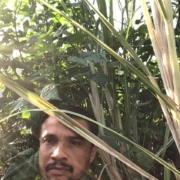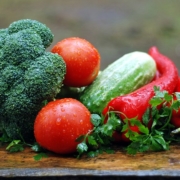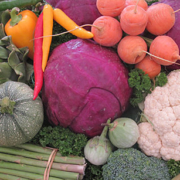Agroecological Crop Selection, Part 1
 Print This Post
Print This Post
By Justin Duncan, NCAT Sustainable Agriculture Specialist
For the past couple years, NCAT has worked with the Southern Risk Management Education Center to provide training to farmers on how to better decide which crops to plant based on agroecological methods. This blog series will summarize the subject matter we shared with producers during those classes.
What do you want to grow versus what wants to grow there? The classical conflict: man against Nature. Humans throughout history have explored new areas and brought familiar crops with them but also exploited species for food, shelter, and fiber from the new area, as well. Some crops do well in those new areas, and others suffer from poor yield, pests and diseases, and other problems that lead to crop failure. What makes the difference between success and failure in these growing systems?
One consideration is wild relatives. What is growing on the site already that is related to the desired crop? A good example of this is blackberries. How well are the wild blackberries or dewberries growing there already? Some wild blackberries are infested with orange rust, but not all of them. The common practice is to clear infected blackberries out of the area and to plant resistant varieties. Instead of doing that, question the wisdom of planting blackberries there at all. Something about that site is just not right for them, so plant something else altogether that is more suited to that particular environment. This will save on input costs. Telltale signs that a crop would potentially thrive can be things like wild grapes, persimmons, and members of the rose family. If wild relatives are growing there AND flourishing, it would be a good bet that one of its cultivated cousins would grow there, too. Knowing a bit about taxonomy can be helpful in making inferences about which crops will do best on a given piece of ground.
Another consideration are guilds/complexes. Plants grow in communities. Understanding these communities can be helpful when choosing crops that will grow without needing too much intervention. Much like the wild relatives, the members of these communities or guilds can be used to make inferences of less risky crops to plant, but unlike using whole plant families as indicators, individual species need to be considered. For instance, in my area, if wild persimmons (Diospyros virginiana) are doing well, then dewberries (Rubus trivialis) will also do well and, by extension, blackberries should also thrive. Other members of this complex include yaupon holly (Ilex vomitoria), American beautyberry (Callicarpa americana) and sassafras (Sassafras albidum). Using complexes to judge where it’s best to plant certain species can be complicated because the range of the individual members can be extensive. I would not base crop selection on just one member of the complex, but several. This will vary by location and requires an understanding of the local flora.
The point of agroecological crop selection is mainly input reduction. As the costs of inputs rise, profit margins decrease. Part of sustainability is profitability and without the latter, the former becomes superfluous. In every place humans have settled, they learned to make use of local plants for food. Therein lies a key: wherever you are, whatever the soil type — as long as something can grow there — the people that came before you knew of plants there to use as food. It’s likely these earlier people in the area were living harmoniously with Nature and were able to feed themselves without the use of any commercial inputs. Likewise, wherever you are, there is some place on Earth that is similar, and crops from those areas should grow well for you. My location is southeast Texas, and the long, hot, dry, brutal summers here cause many farmers and gardeners to rest for the season. I rest during the heat, too, but not before planting cassava, sugar cane, sweet potatoes, and chaya. These crops do well for me, but why? The cassava and chaya are both members of the Euphobiaceae. I knew they would do well for me based upon their wild relatives: Euphorbia maculata, Triadica seberifera, and Euphorbia heterophylla. Another of their wild relatives, Texas bull nettle, grows nearby shares the same Genera as chaya: Cnidosculus. While many people consume the cassava tubers, I use the leaves as a fortifying green. They are delicious and healthy. Moreover, they can tolerate the summer without any inputs.
Agroecological crop selection has many other benefits. Stay tuned to learn more in the next installment of this blog series, which is graciously funded by the Southern Risk Management Education Center.
Related ATTRA Resources:
Crop Selection and Planting Schedules for Winter High Tunnel Production
Other Resources:
Southern Risk Management Education Center
This blog is produced by the National Center for Appropriate Technology through the ATTRA Sustainable Agriculture program, under a cooperative agreement with USDA Rural Development. This blog was also made possible in part by funding from the Southern Risk Management Education Center, USDA National Institute of Food and Agriculture, through the University of Arkansas. ATTRA.NCAT.ORG.


 NCAT
NCAT





 Wikimedia Commons, LSDSL
Wikimedia Commons, LSDSL Canva Pro
Canva Pro
